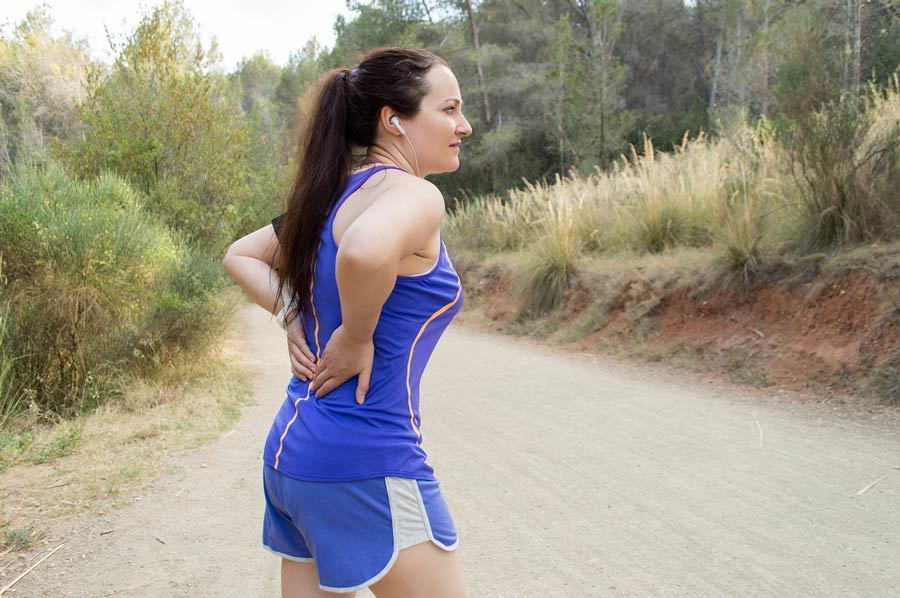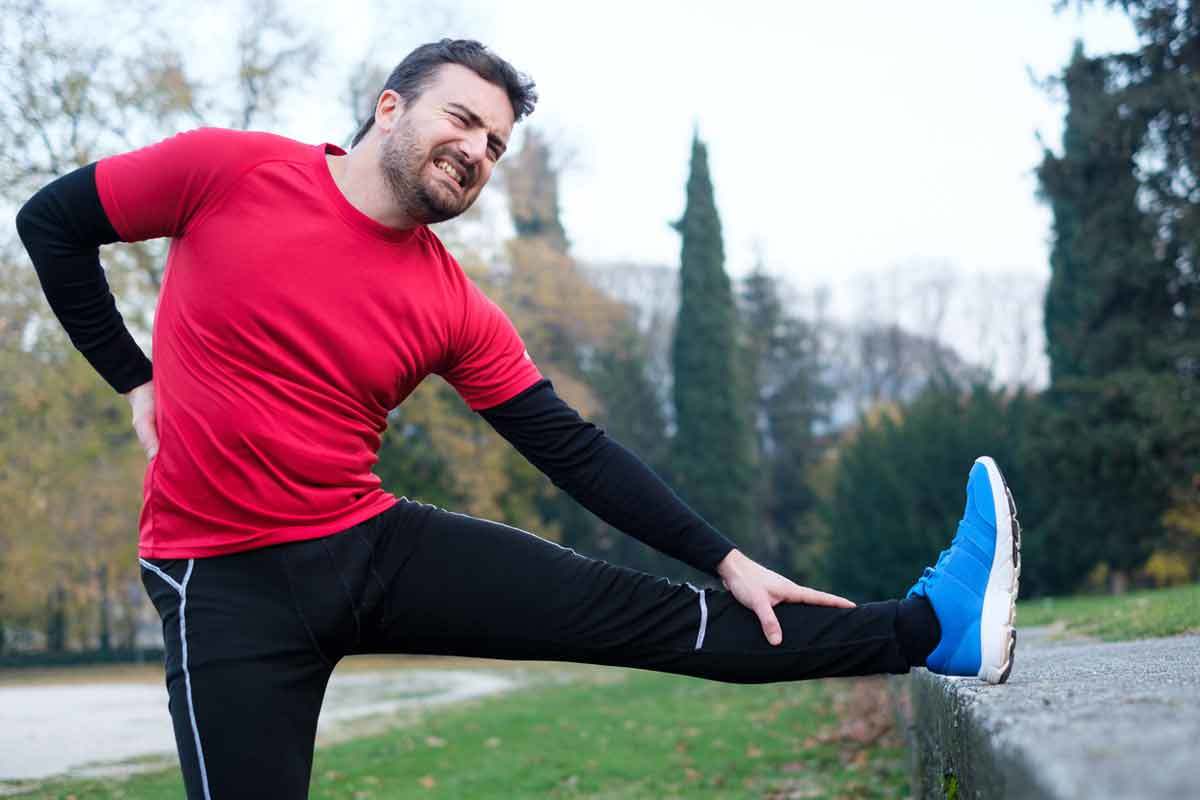This post contains references to products from one or more of our advertisers. We may receive a small commission at no extra cost to you should you make a purchase of any these products.
Back pain is not normally associated with running.
So learning how to prevent lower back tightness while running is important.
Usually, you expect to be out of breath, have weak legs and an overall feeling of exhaustion.
But actually many runners report that they experience back pain when running.
Running is a high impact sport.
There are many reasons why runners have back issues.
A lot of time it can be attributed to bad form and not strong enough muscles to support this strenuous activity.
Running mechanics plays a large role in how good you'll feel when you run or how hard it will be.
Or it can be tied to the fact you've put on a little weight recently. Head over to Amazon to get a copy of my new book to help get you on track.

The stronger and more flexible you are, the better runner you'll be.
For those who have experienced back pain during or after a run, it can be painful and debilitating.
So what brings on the back pain from running?
In this post, we will discuss the reasons why people experience back pain when running.
Also, we will give advice on ways to prevent back when running.
Why Your Back Hurts During or After Running

Why should your back hurt when you run?
It takes a lot of muscles working together to get you running.
When a group of these muscles, like your legs, become fatigued then other muscles have to step in and make up for the deficit.
Unfortunately, this usually means your lower back has to do more work to keep you running.
Keeping the body upright and moving means using a lot of body parts and if one of them is weak or has become tired then pain in other areas especially the back will occur.
It is similar to the stress felt by your knees.
Lower Back Pain Can Occur After All Sports
During a run, the lower back and spine have to be strongly supported by the core muscles.
But we're not talking about your abdominal muscles that you see when you take your shirt off.
Those are superficial muscles and aren't the real muscles that support when you run.
Instead, there are deep core muscles.
They actually attach to the spine which provides stability and flexibility for movement of your back.
Additional stability comes from the hips, hamstrings, and glutes.
When all these components are working together efficiently, running will feel easier.
However, if any of these parts are weak, your form deteriorates and undue stress is put on other areas of the body.
This is especially true if you're running long distances.
Often times it's the lower back that feels the strain and subsequently leads to pain.
And in certain cases, an injury to the back will occur.
This is why body mechanics, form and strength is vitality important to keep you running safely.
The other problems runners experience in their lower back include:
- A chronic pain radiating on the lower back indicates arthritis
- Muscle spasm is an acute pain that suddenly occurs on the lower back
- Sciatica is the chief cause for the sharp and shooting pain felt in this area
Upper Back Pain
Another area often compromised when running is the upper back.
Proper form comes into play here again.
Most people usually don't think about their head when they run, but it's positioning is important.
The position of the head is the main cause of pain in the upper back.
You don't want to run with your head leading or extended out in front of your body.
This creates an unnatural strain on the muscles of the upper back.
These muscles will become fatigued easier and will eventually lead to back spasms.
Also, this might seem obvious but make sure you're looking straight ahead.
When fatigue starts to set in, our chin tends to tilt downward.
With proper form, your head should be upright and your ears in line with your shoulders.
Watch Those Shoulders And Arms During Activities
Shoulders are another important thing to consider.
They need to be relaxed and pulled back.
If you've been running for an extended period of time and are becoming increasingly tired, the shoulders will start to pull forward in a hunched position.
Which, in turn, causes undue stress and tension in the upper back and neck.
It also wastes a lot of energy because you're not running efficiently.
Don't forget about your arms.
The position of the arms during a run will also cause upper back pain.
Arms should be held close to the body at a 90-degree angle.
When the arms are too high and the elbows start to jut out, this causes your hands to cross over your body.
This positioning will waste energy and fatigue will set in quicker.
Subsequently, the muscles of the upper back will spasm and create pain.

How Can Low Back Pain be Prevented?
You don’t have to give up running because of lower or upper back pain.
What you need are timely solutions to get you up and running.
Switch/replace running shoes.
The varied position of the soles of running shoes plays an important role in your posture.
Go to a store specializing in running.
They will analyze your gait and put you in the proper shoe.
Also, remember running shoes do have a short lifespan.
You want to change them out every 300-500 miles of running.
Switching out running shoes yearly is a must for runners doing a weekly run of 6 miles.
Marathoners or runners that do multiple races a year might have to get new ones every 3-4 months.
Also having athletic insoles may help to absorb the impact of running.
There are ones that are over the counter or specialty stores and podiatrists offer custom orthotics.
Core Strengthening Exercises For The Family
The pain you feel in the lower back will be dramatically reduced by doing core exercises.
We not talking about sit-ups or crunches though.
Strengthening the deep core muscles of the body makes it flexible and strong.
To train the deep abdominal muscles, you must due core exercises that require you to stabilize the body.
Doing squats on a Bosu ball or single leg pistol squats on the ground help to work the needed muscles.
Try these core strengthening workouts to ease lower back tightness while running:
- Bicycle crunches provide flexibility to the hips as well as builds strong abdominal muscles. Lay on the back on the ground with hands behind your head. Take your right knee and bring it up to your left elbow while keeping your left leg straight and off the ground. Alternate back and forth. Try to do 3 reps of 20.
- Ball pike exercises increase flexibility and mobility of the hips. The back and core are also strengthened with this workout. Start on all fours on the ground. One at a time place each foot on an exercise ball. Then pull your feet to your chest while raising your hips into a V shape. This is a difficult move so do as many as you can. Ideally 3 sets of ten.
- Warrior three single-leg lifts help to improve stability and balance. Doing this particular workout also gives the hips greater flexibility, strengthens the hamstrings and glutes, and strengthens the core. Stand up straight with arms above your head and palms facing each other. Extend one leg back while your upper body hinges forward at the waist. Keep bending til your body in a T shape. Then straighten back to standing. Again this is a challenging move if you don't have good balance. Try to do 10 on each side for 2-3 rounds.
Proper Posture
Bad posture will also affect your running ability.
Good posture has to be maintained in all daily activities to achieve maximum health benefits.
Prolonged standing in one position, hunching over the computer or improper sitting positions all affect the muscles of the back.
If you find that you do sit for long periods of time, you should consider getting an adjustable standing desk.
When standing for long periods is unavoidable, the solution is to shift to another position after 10 minutes.
Standing on hard surfaces for long periods will also affect your posture.
To lessen the effect, wear shoes with support or cushioning features.
If your workplace allows, try ergonomic mats to ease the impact of a hard surface.
If You Have To Sit
In cases where you are sitting for extended amounts of time, ensure that both buttocks are seated firmly.
Keep your shoulders back and your spine elongated.
The chair should have an arch that supports your lower back with both feet easily rested on the floor.
A new chair seen in the workplace is a balance ball chair.
They are designed to strengthen core muscles as well as increase energy and productivity.
Spinal disc decompression
Running is considered as high-impact physical activity.
One of the best ways to reverse the high-impact effects is by decompressing the spinal discs with the help of an inversion table.
The inversion table offers several health benefits other than spinal decompression, to include:
- Increased flexibility
- Muscle tension reliever as it realigns and elongates the spine
- Provides maximum stretch to shoulders, legs, upper back, and hips
- Increases the length of the spine
Changing The Running Surface

The spine gets a hard jolt every time running is done on asphalt and concrete surfaces.
This shock goes from the foot all the way to spine.
A hard surface doesn't absorb any of the impact.
Over time the lower back muscles and spine will suffer from the jarring impact of running on pavement or cement.
The impact is considerably reduced if you run on a synthetic track and dirt trails.
This is because the force is evenly distributed to other muscles of the body other than the spine alone.
Other Things To Consider
If you are training for a race be careful not to increase your mileage too quickly.
A good rule of thumb is adding 2 miles per week.
Ramping up your mileage more than that can lead to an injury. Also make sure you're properly warmed up before you start running.
Do a light jog for 5-10 minutes then increase to your normal speed.
Stretching afterward is extremely important.
This keeps the muscles flexible which in turn will decrease your chance of experiencing lower back tightness while running.
Here are some easy remedies to alleviate lower back tightness while running:
- Maximum bed rest of two days
- Application of cold or hot packs to the painful area.
- Gentle movements and walking around
- Minimal stretching or straining of the back while doing activities of daily living
- Avoid bending. If you have to pick something up from the floor, squat instead of bending.
Conclusion
A study done by The Ohio State University Wexner Medical Center has found that lower back pain is caused when the body has a weak core.
The deep abdominal muscles that attach to the spine need to be strong in order to stabilize the back.
If the vertebrae is not supported properly pain will occur in the lower back. Continued running in this condition will lead to a possible injury.
This puts across the message that the best way to keep running and avoid pain or a back injury is to strengthen your core.
Other helpful tips include running on softer surfaces, having proper shoes, and correct posture.
Combine all these and you should be able to run pain-free.